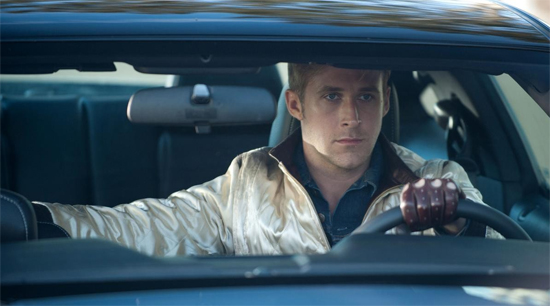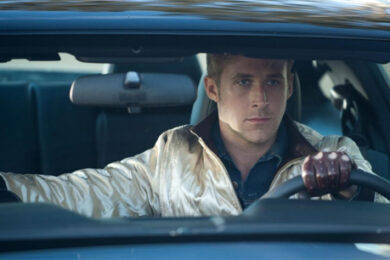“One thing he could do, though, was drive. And he drove like a son of a bitch.”
James Sallis’s 2005 novel Drive is traditional, hardboiled American noir. It tells the story of an unnamed protagonist, Driver – defined only by what he does – in a series of obliquely sorrowful vignettes and violent flashbacks, loosely held together but firmly anchored by the clichés of the genre. It’s so consciously recognisable as part of the noir tradition that whether it succeeds or fails as a novel is likely to depend almost entirely on your tolerance for these clichés and willingness to look below the surface for something more substantive.
The same could be said for Nicholas Winding Refn’s new adaptation of Drive – but to a much lesser extent. Hossein Amini’s script and Winding Refn’s Cannes-prize-winning direction have produced a terrifically entertaining piece of cinema that succeeds at reinvigorating the genre in a way that’s eluded other comparable films. It’s done this by embracing noir clichés with such energy and verve that they feel fresh and thrilling all the way through. It effortlessly produces the kind of goodwill that the best ‘genre’ films do – it offers the comfort of familiarity and cinematic gorgeousness shot through with glimpses of emotion. Its stylish beauty creates an instant complicity with the viewer, inspiring a willingness to forgive its flaws, and its sentimentality cements the desire to believe in something special, even joyful, at the heart of it.
Winding Refn began his career in his native Denmark with Pusher (1996) and Bleeder (1999) – ultra-violent, stylish, savage thrillers. He went on to direct Pusher II and III, before making prison drama Bronson and historical fantasy Valhalla Rising in English. His move to Hollywood seems likely to be more successful than that of some other Scandinavian directors – his style is skilfully shaped to fit with Hollywood’s artistic pretensions and demands for certain types of structure. This is something many equally good fellow Scandinavians, e.g. Susanne Bier or Thomas Vinterberg, haven’t seemed to crack yet, and von Trier’s fear of flying has probably saved him from. To be fair, Winding Refn’s sensibilities have always been more ‘Hollywood’ – the Pusher films are the kind of modern, morally ambivalent, blackly humorous, self-aware gangster movies that Hollywood loves to congratulate itself on making.
Drive could be counted one of these – it’s got a standard plot about gangsters, gory violence and car chases – but it also plays slyly on the expectations that come with making such a thriller. Driver’s a wheelman, a movie stunt driver. He shows up on location, drives, moves on. The anonymity suits him, not just because of his part-time career as a getaway driver, but because he creates scenes the way he fits into people’s lives. He sells strangers choreographed, isolated moments. Often, he doesn’t even read the screenplays, just as he takes no responsibility for robberies he drives in. Driver’s refusal to engage with noirish stories could be read as his attempt to escape a generic role, and paradoxically, it’s breaking this rule and descending into cliché that’s the spark in the engine of the plot. But it’s not the tragedy of the heist-gone-wrong that makes the film works, it’s the fact that the catalyst for it is sentiment.
Drive is not an emotionally sophisticated film, but if you’re willing to buy into it, it’s deeply romantic. The symbolism is straightforward. On set, Driver wears masks, hiding his feelings behind others’ faces. His own expression is usually impassive; he can only display real emotion through driving (the way he expresses anger or sadness in his handling of a car is just beautiful). The point that all this is also a disguise is underscored by Hallowe’en masks, balaclavas and the way Blanche (Christina Hendricks) repairs her make-up when she’s scared. Here, what lifts the clichés out of the ordinary is Ryan Gosling’s fantastic performance. Gosling doesn’t so much play Driver as inhabit him, with wonderful grace and economy and striking stillness. When he does allow a smile to cross his face, however trite the reason, it’s utterly believable, like the sun coming out.
The supporting cast are excellent too, from Carey Mulligan’s innocent Irene to Ron Perlman’s grotesque Nino. That’s not to say the characterisation is any less noirishly one-dimensional than that of the novel. Women are mothers or whores, men live in thrall to an old-fashioned code of honour amongst thieves that doesn’t make any kind of actual sense outside of gangster lore. This is true of the ordinary, washed-up petty criminals as much as it is of the classic megalomaniac gangsters (one comic, one tragic). Dialogue is spare; conversations are theatrical, even affected. The camera remains quiet when people talk. Everyone’s trapped in their roles. But they’re also made just real enough by surprising details – Nino’s humour, Bernie’s distaste for LA, Standard’s vulnerability. Passions lie behind the generic masks.
Essentially, its noir sensibilities position Drive somewhere along that blurry line between genre and pastiche. The aesthetic is ‘80s-but-classy – visually and musically, it reads more than anything like an off-centre homage to Michael Mann. It’s there in the neon pink retro styling of the credits, the gorgeous, heavily saturated blues and reds and oranges of the production design, the Collateral-style aerial shots panning across LA’s night-time cityscape, the ridiculously lovely electronica of Cliff Martinez’s soundtrack. The same kind of wistful intensity that characterises so much of Mann’s work has been lovingly overlaid onto Drive. Look at the fluid, stylish action scenes, glossy and sharp, never scratchy or messy. The precise editing lends them such controlled grace, and has the way the timbre of an engine shifts during gear changes ever been used so effectively?
Sallis’s source novel is not so glossy. It’s no less tightly written than Amini’s screenplay, but its structure is looser, the plot less securely predictable as it slips backwards and forwards in time. Secondary characters drift in and out of the narrative, fading into the foreground of Driver’s life and back out again. The film takes the elegant, spare bones of the novel, strips them of some of its stranger, sweeter vignettes (it’s worth reading just for Driver’s relationships with Jodie, Doc and Miss Dickinson) and fleshes them out again with hard, tangible cinematic details. Uncomfortable heels, rich colour, shifting pools of shadows. The poignant futility of hastily packed suitcases, the frisson you get watching a man putting on driving gloves. The twist of emotions only music can elicit, the hard splintery bite of a toothpick.
Drive points up something essential about genre and the process of adaptation, something Mann understands in a way Winding Refn seems keen to emulate. It’s comparable to his fabulous, haunting Manhunter. Each film takes a decent genre novel and transforms it into something else, not necessarily better, but essentially cinematic. Each makes its own rules as vital as the novel’s. Mann’s 2006 Miami Vice is interesting by contrast – it was denied the reception it deserves because many people found its dreamy looseness and lack of fidelity to his original show deeply unsatisfying. At least Drive is unlikely to suffer this – it’s more accessible than the book.
So many recent noir films have been stolid and disappointing, like Scorsese’s The Departed, or the adaptations of Dennis Lehane’s Mystic River and Shutter Island. They take the word ‘noir’ literally – even great films like The Yards are soaked through with grey visually and emotionally. But like Mann’s work, Drive paints the world with bright colours. It’s utterly confident in its emotional simplicity; by turns, sentimentality and violence become entirely reasonable.
Drive’s one-dimensional characterisation, extreme violence and obtuse plot holes are at best comfortingly familiar. It takes the juxtaposition of the stylish, exhilarating direction and achingly romantic, emotional subtexts to underpin them with enough truth and flair to produce at least the illusion of something satisfying. But even if it’s only an illusion, it’s one that lasts – Drive is the first film in a long time that I can’t wait to see again. It’s mired in clichés, but Drive puts its whole heart into them, celebrates them, dares you not to love them. That’s the something special at its centre. It makes its flaws pure, its ugliness beautiful.



